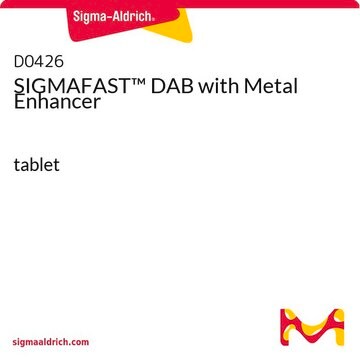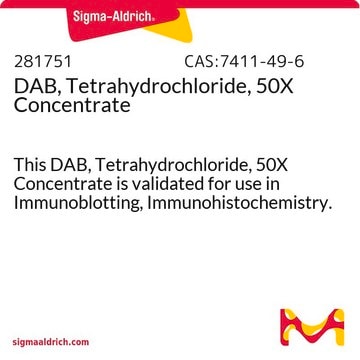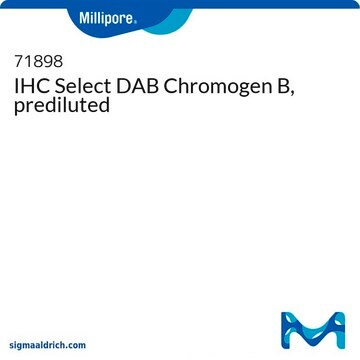D7304
3,3′-Diaminobenzidine (DAB) Liquid Substrate System tetrahydrochloride
Synonym(s):
Chromogenic substrate, DAB substrate solution
Sign Into View Organizational & Contract Pricing
All Photos(1)
About This Item
UNSPSC Code:
12352203
NACRES:
NA.46
Recommended Products
General description
3,3′-Diaminobenzidine (DAB) is a chromogenic substrate for peroxidase enzyme and is useful as a staining agent in immunohistological and immunoblotting techniques. The end product is resistant to alcohol therefore, a variety of counterstains and mounting media can be used with the DAB Liquid Substrate System. The DAB Liquid Substrate System provides all the chromogen and buffer/peroxide solutions needed to produce a fast and convenient DAB substrate solution..
Application
3,3′-Diaminobenzidine (DAB) Liquid Substrate System tetrahydrochloride has been used as a substrate:
- in the immunoblot assay carried out to identify the changes in heat shock proteins (Hsps) expressed in the liver
- for visualization of sections after immunostaining
- in immunohistochemistry of mice knee joint sections
- in the immunolabeling of kisspeptin neurons in the preoptic area of camel
Caution
Stable at least one year at 2-8 °C.
Quantity
Each DAB Liquid Substrate System will provide 250 mL of DAB substrate solution.
Disclaimer
Unless otherwise stated in our catalog or other company documentation accompanying the product(s), our products are intended for research use only and are not to be used for any other purpose, which includes but is not limited to, unauthorized commercial uses, in vitro diagnostic uses, ex vivo or in vivo therapeutic uses or any type of consumption or application to humans or animals.
Kit Components Only
Product No.
Description
- 10X DAB Liquid Chromogen 25 mL
- ready-to-use buffer/peroxide solution 250 mL
Signal Word
Danger
Hazard Statements
Precautionary Statements
Hazard Classifications
Acute Tox. 3 Dermal - Acute Tox. 3 Inhalation - Acute Tox. 3 Oral - Carc. 1B - Flam. Liq. 2 - STOT SE 1
Target Organs
Eyes,Central nervous system
Storage Class Code
3 - Flammable liquids
WGK
WGK 3
Choose from one of the most recent versions:
Certificates of Analysis (COA)
Lot/Batch Number
Don't see the Right Version?
If you require a particular version, you can look up a specific certificate by the Lot or Batch number.
Already Own This Product?
Find documentation for the products that you have recently purchased in the Document Library.
Customers Also Viewed
S R Pitkin et al.
Behavioural brain research, 119(2), 167-177 (2001-02-13)
The present study aimed to assess the role of advanced age in the development and manifestation of thiamine deficiency using an animal model of Wernicke-Korsakoff syndrome (WKS). Interactions between pyrithiamine-induced thiamine deficiency (PTD) and age were examined relative to working
K M Mader et al.
Genes, brain, and behavior, 7(7), 740-753 (2008-06-04)
Mucopolysaccharidosis type IIIA (MPS IIIA) is an inherited neurodegenerative lysosomal storage disorder characterised by progressive loss of learned skills, sleep disturbance and behavioural problems. Reduced activity of sulphamidase (SGSH; EC 3.10.1.1) results in intracellular accumulation of heparan sulphate (HS), with
The dromedary camel displays annual variation in hypothalamic kisspeptin and Arg-Phe-amide-related peptide-3 according to sex, season, and breeding activity
Ainani H, et al.
The Journal of Comparative Neurology, 528(1), 36-51 (2020)
Gamze Tanriover et al.
Clinical breast cancer, 18(5), e1067-e1076 (2018-05-29)
Increased S100A8/A9 expression in Gr1-positive cells has been shown in myeloid-derived suppressor cells and may play a role in the formation of a metastatic milieu. We aimed to determine S100A8/A9 expression alone and with coexpression of Gr1 (a myeloid marker)
Christian Dölle et al.
Scientific reports, 8(1), 1272-1272 (2018-01-21)
3,3'-Diaminobenzidine (DAB) is a widely used chromogen in histological staining methods and stained tissue is often used in downstream molecular analyses such as quantitative PCR (qPCR). Using microdissected muscle fibers from sequential muscle sections stained by DAB-dependent and -independent methods
Our team of scientists has experience in all areas of research including Life Science, Material Science, Chemical Synthesis, Chromatography, Analytical and many others.
Contact Technical Service










